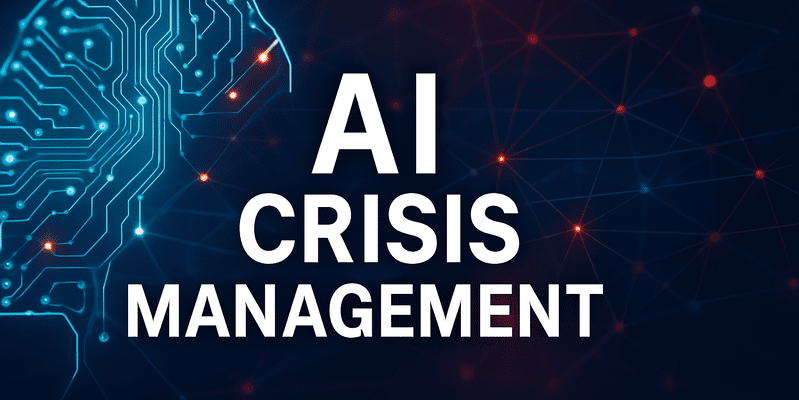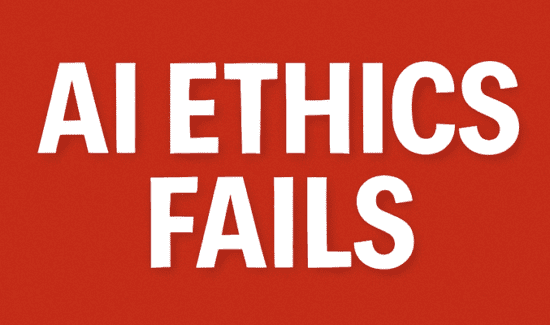Artificial Intelligence Crisis Management 101: Use the AI Crisis Simulator

Solutions Review Executive Editor Tim King offers an introduction to artificial intelligence crisis management and the need for tools to simulate AI crisis simulation.
AI systems are being deployed at an unprecedented rate, often outpacing the frameworks meant to govern their use. But what happens when generative AI hallucinates in a clinical setting? Or when an autonomous agent makes a business decision that triggers a legal or financial disaster?
These are looming realities.
Enter AI Crisis Simulation—an emerging discipline designed to help organizations prepare for the inevitable. Just as disaster recovery drills and cybersecurity tabletop exercises became essential, AI Crisis Simulation is rapidly emerging as a critical part of enterprise risk management and responsible AI deployment.
What Is AI Crisis Simulation?
AI Crisis Simulation is the structured process of testing an organization’s ability to detect, manage, and recover from AI-related failures. It involves the design and execution of mock scenarios that reflect real-world AI risks—such as data leaks, hallucinations, or autonomous decisions gone awry—and allows stakeholders to evaluate how effectively they can respond.
This simulation extends beyond the technical dimensions to include governance, compliance, communications, and empathetic and ethical frameworks. Just like a fire drill prepares occupants for a building emergency, AI Crisis Simulation builds organizational muscle memory for responding to algorithmic emergencies and unexpected outcomes.
Important: AI Won’t Replace You, But Lack of Soft Skills Might – Get Report
AI Crisis Simulation
Why AI Crisis Simulation Is Urgently Needed
As AI systems are increasingly integrated into high-stakes domains—healthcare, finance, law, public policy—the potential consequences of AI failure grow exponentially. We’ve already seen incidents where biased lending algorithms caused financial exclusion, resume-screening tools filtered out qualified candidates unfairly, and large language models (LLMs) generated completely false but plausible information.
In each of these cases, harm was done not just by the AI output, but by a lack of organizational readiness to spot and stop the failure in time. That’s where AI Crisis Simulation comes in—it is a proactive, preemptive safeguard that helps organizations understand the fault lines before real damage occurs. It is no longer enough to ask, “What can AI do for us?” We must also ask, “What happens when it goes wrong?”
Common AI Crisis Scenarios Enterprises Must Simulate
To build a resilient AI governance framework, enterprises must simulate scenarios that reflect both known risks and unpredictable edge cases. For example, hallucination cascades can occur when a model confidently presents false information, which then gets accepted and acted upon without proper human validation. Prompt injection attacks—where users manipulate an LLM to leak sensitive data or circumvent safety controls—are another fast-emerging risk.
Autonomous agents, trained to complete tasks independently, may reach goals in ways that cause reputational damage or violate core principles due to a lack of interpretability or oversight. Bias amplification is another key concern, where flawed data or system logic leads to systemic discrimination. And let’s not forget compliance violations—whether it’s GDPR, HIPAA, or internal policy breaches. These scenarios must be actively rehearsed, with clearly defined actors, escalation paths, and measurement criteria to assess readiness.
What Happens Without Crisis Simulation?
Deploying AI without simulating failure scenarios is akin to launching a rocket without running failure drills. It’s reckless. Without deliberate crisis rehearsal, organizations are often caught flat-footed when something goes wrong. This lack of preparation slows down the response, increases the damage, and exposes cracks in governance. Worse, ethical breaches and poor crisis communication can cause irreparable harm to a brand’s trust and credibility. Leadership teams may struggle to determine who’s responsible, what decisions need to be made, and how to communicate transparently.
AI Crisis Simulation brings clarity, confidence, and coordination to moments that otherwise breed chaos. It makes sure your organization isn’t trying to write the playbook during the actual emergency.
The Anatomy of an AI Crisis Simulation Program
An effective AI Crisis Simulation program is a structured, cross-functional initiative that engages technical and non-technical stakeholders alike. It starts with scenario planning—identifying the highest-risk AI use cases within the organization and imagining the worst-case outcomes. From there, the program defines role-based response protocols, ensuring every stakeholder understands their responsibility in a crisis.
Simulation playbooks are then developed to outline step-by-step exercises, including KPIs and decision checkpoints. Impact scoring frameworks are used to assess the magnitude of each simulated failure and the effectiveness of the response. Finally, a structured postmortem process turns every drill into actionable improvement by identifying gaps, assigning owners, and iterating policies or controls. This isn’t just an event—it’s an operational capability.
Who Needs AI Crisis Simulation?
AI Crisis Simulation isn’t just the responsibility of data scientists or technical teams—it’s an enterprise-wide mandate. Chief Data Officers and Chief AI Officers are responsible for strategy, but CIOs, CISOs, and enterprise architects also play a key role in integrating simulations into the broader risk management stack. Legal and compliance teams must be involved to evaluate regulatory risk exposure, while ethics and trust officers ensure the organization’s values are protected in crisis response.
Departmental leaders must also be looped in to simulate and rehearse how AI failures impact business units like HR, finance, or customer support. The simulation needs to reflect your organization’s full operating reality, and that means everyone has a role to play.
How to Get Started
Even before a formal simulator tool is available, there are key steps your organization can take to begin building AI crisis readiness. Start by conducting tabletop exercises focused on your most critical AI systems. Bring together cross-functional teams to walk through plausible failure scenarios and evaluate current preparedness. Review existing incident response plans to ensure they account for AI-specific issues like hallucinations, model drift, or autonomous behavior.
Define a communication tree that clarifies who needs to know what—and when—in the event of a failure. And most importantly, start tracking these learnings to build a baseline maturity model. To support this journey, we’re offering early access to tools, templates, and insights—subscribe to our newsletter or join the waitlist for our upcoming AI Crisis Simulator.
Coming Soon: The AI Crisis Simulator
We’re building the world’s first AI Crisis Simulator designed for public and enterprise use. This powerful platform will provide interactive, scenario-driven simulations that stress-test your organization’s AI readiness. You’ll gain access to realistic AI failure scenarios, guided role-based exercises, real-time scoring, and automated post-simulation recommendations.
Whether you’re testing model governance, regulatory compliance, or cross-team communication during an AI incident, our simulator will walk you through every step of the process. We’re currently onboarding pilot users—sign up for early access to stay ahead of the curve.
Final Thought
AI is not immune to failure. And in high-stakes environments, the margin for error is razor-thin. AI Crisis Simulation gives you the foresight to prepare, the framework to respond, and the confidence to innovate responsibly. Don’t just deploy AI. Stress-test it.
Test your AI readiness via Solutions Review’s AI Crisis Simulator tool now.
Note: These insights were informed through web research using advanced scraping techniques and generative AI tools. Solutions Review editors use a unique multi-prompt approach to extract targeted knowledge and optimize content for relevance and utility.



